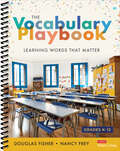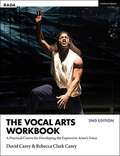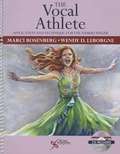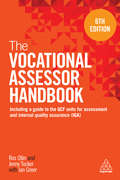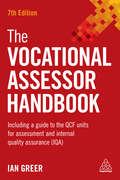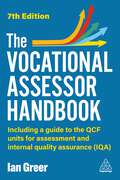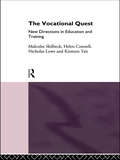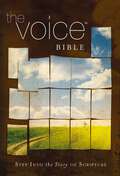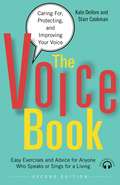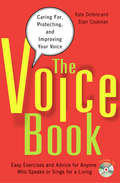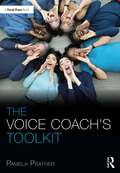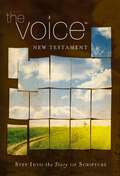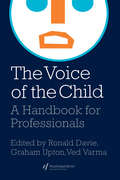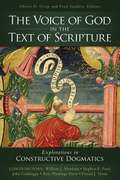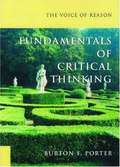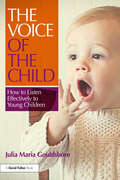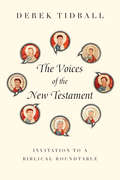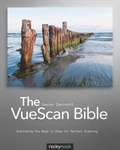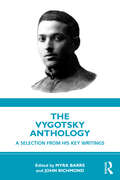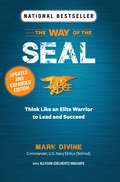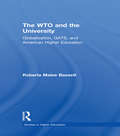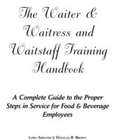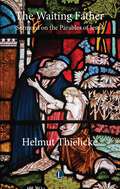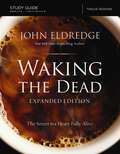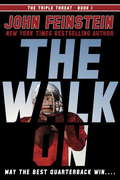- Table View
- List View
The Vocabulary Playbook: Learning Words That Matter, K-12
by Douglas Fisher Nancy FreyConcepts, conversation, collaboration—vocabulary instruction is so much more than lists of words. More is more when it comes to students’ vocabulary knowledge, and in The Vocabulary Playbook, educators in K-12 get ideas for transforming all children into curious, capable word learners. The key? Put away the word-list mindset, and embrace active modeling, peer work, and independent practice. Five modules offer direct instruction and effective routines that show how to: Select and teach only the most high-utility, transferable words that are ripe for discussion Use direct instruction to model word-solving in each content area Teach morphology in ways that invite students to apply understandings in reading, writing, talk, and listening Turn academic word-learning into a relevant experience with peer collaboration activities Create a culture of word consciousness by emphasizing concepts, modeling curiosity, and offering "low-risk" routines that make it okay to not yet know Intentional vocabulary instruction is critical in every grade, and in every content area. With The Vocabulary Playbook, your approach is now tactical, transparent, and fun. Whether you are an administrator executing a school-wide plan or a teacher eager for practical strategies, this is the book that will help students build academic success—word by word.
The Vocal Arts Workbook: A Practical Course For Developing The Expressive Actor's Voice (Rada Guides)
by David Carey Rebecca Clark Carey"Refreshing and imaginative, this book teaches through enhanced awareness and instructs through clear and specific exercises." Cicely Berry A practical course for actors and other professional voice-users to achieve clarity and expressivity with the voice. Setting out the fundamental principles of voice training, the book provides structured and informed methods for developing vocal power, range and flexibility. At the heart of the book are practical projects with exercises which enable you to: - connect your breath with your voice - meet the demands of your performance - use your voice expressively through fully controlling pitch and range Each chapter consists of an introductory framework; explorations; exercises; follow-up work; suggested texts and further reading altogether offering a unique, student-centred approach not found in other voice books. This revised edition speaks more directly to the actor, rather than the voice teacher, through revised terminology and descriptions, updated references, additional appendices on health and other issues related to trends in contemporary drama and questions of equality, diversity and inclusion with respect to vocabulary and suggested texts. Includes forewords by Cicely Berry and Fiona Shaw.
The Vocal Athlete: Application And Technique For The Hybrid Singer
by Marci Daniels Rosenberg Wendy LeBorgneThe Vocal Athlete: Application and Technique for the Hybrid Singer is a compilation of voice exercises created and used by well-known voice pedagogues from preeminent colleges, established private studios, and clinical settings. The exercises focus on various aspects of contemporary commercial music (CCM) including bodywork, mental preparation, registration, and much more. The book is designed to accompany its companion text, The Vocal Athlete-a first of its kind in singing science and pedagogy developed for singers of all styles, with a particular emphasis on CCM.. Also included is a CD of the singing exercises to further enhance understanding of techniques and skills used in training this type of singer. Both The Vocal Athlete: Application and Technique for the Hybrid Singer and its companion text are invaluable tools for anyone who uses or trains the singing voice or works with CCM singers.
The Vocational Assessor Handbook: Including a Guide to the QCF Units for Assessment and Internal Quality Assurance (IQA)
by Ian Greer Ros Ollin Jenny TuckerFor assessors of QCF qualifications and NVQs, verifiers, school and FE college teachers, providers of training and work-based learning and those working towards PTLLS, CTLLS, DTLLS teaching qualifications, The Vocational Assessor Handbook contains a detailed guide to the following QCF units for assessment and internal quality assurance (verification) enabling readers to:-Understand the Principles and Practices of Assessment (Knowledge and Understanding Unit)-Assess Occupational Competence in the Work Environment-Assess Vocational Skills, Knowledge and Understanding-Understand the Principles and Practices of Internally Assuring the Quality of Assessment (Knowledge and Understanding Unit)-Plan, Allocate and Monitor Work in Your Own Area of ResponsibilityPacked with the most up to date, detailed and reliable guidance, The Vocational Assessor Handbook is the only book for assessors and verifiers of vocational qualifications and is essential reading for anyone involved in vocational education. Previously published as The NVQ Assessor, Verifier and Candidate Handbook, this revised edition includes fully updated terminology as well as the latest information on regulations and qualifications.
The Vocational Assessor Handbook: Including a Guide to the QCF Units for Assessment and Internal Quality Assurance (IQA)
by Ian GreerIndispensable for anyone involved in vocational education or apprenticeships, this fully revised and updated edition of The Vocational Assessor Handbook includes new guidance on end-point assessment of the new apprenticeship standards, and the latest information on regulations and qualifications. Containing the units and practical explanation for each stage of assessment and verification practice, it is the only comprehensive guide for assessors and verifiers of vocational qualifications.Packed with up-to-date, detailed and reliable information, The Vocational Assessor Handbook (previously The NVQ Assessor, Verifier and Candidate Handbook) contains a detailed guide to the QCF units for assessment and internal quality assurance (verification). For UK assessors of QCF qualifications and NVQs, verifiers, teachers, providers of training and work-based learning, assessors of apprenticeships and those working towards PTLLS, CTLLS, DTLLS qualifications, this complete guide is essential for qualification and ongoing practice, enabling you to: understand the principles and practices of assessment; assess occupational competence in the work environment; assess vocational skills, knowledge and understanding; understand the principles and practices of internally assuring the quality of assessment; plan, allocate and monitor work in your own area of responsibility.
The Vocational Assessor Handbook: Including a Guide to the RQF Units for Assessment and Internal Quality Assurance (IQA)
by Ian GreerThe Vocational Assessor Handbook is the only comprehensive guide for assessors and verifiers of vocational qualifications.Written for anyone in occupational training, this book is essential reading for verifiers, teachers, training providers and work-based learning and apprenticeships. It also provides guidance for anyone working towards qualifications in Preparing to Teach in the Lifelong Learning Sector (PTLLS), Level 4 Certificate in Education and Training (CET) and the Level 5 Diploma in Education and Training (DET).This handbook enables you to: · understand the principles and practices of assessment· assess occupational competence in the work environment· assess vocational skills, knowledge and understanding· plan, allocate and monitor work in your own area of responsibilityThe Vocational Assessor Handbook (previously The NVQ Assessor, Verifier and Candidate Handbook) is fully updated to include: · Proposals in relation to establishing a "Skilled Workforce"· The introduction of T Level Qualifications and the growth in apprenticeships · Revisions to the frameworks to QCF/Awarding Bodies Vocational Education & Training (VET)· Changes following the 2024 General Election including new training initiatives
The Vocational Quest: New Directions in Education and Training
by Helen Connell Nicholas Lowe Malcolm Skilbeck Kirsten TaitGovernment attempts in recent years to create a national system of vocational education and training have marked a profound shift both in educational policy and in underlying concepts of what education is for. Relations between schools and the working world are changing all the time and the implementation of ideas of vocationalism has forced a blurring of the time-honoured boundaries between educations concerned with concepts and training, or with skills. The challenge now is to define how the schools can give young people the foundations for life in a working world in which they are likely to have to change jobs and where work will fill a smaller proportion of their lives. The Vocational Quest maps the evolution of vocationalism in Britain in historical terms and examines how the particular forms that have come into being in the last few years compare with developments in other parts of the world, including Continental Europe, Japan, the United States, Australia and New Zealand. It argues for new forms of communication and partnership between formal education and training and the wider community, in which values will be shared and no one partner will win at the expense of others.
The Voice Bible: Step Into the Story of Scripture
by Thomas Nelson. Ecclesia Bible SocietyThe VoiceTM is a faithful dynamic equivalent translation that reads like a story with all the truth and wisdom of God's Word. Through compelling narratives, poetry, and teaching, The Voice invites readers to enter into the whole story of God, enabling them to hear God speaking and to experience His presence in their lives. Through a collaboration of nearly 120 biblical scholars, pastors, writers, musicians, poets, and artists, The Voice recaptures the passion, grit, humor, and beauty that is often lost in the translation process. The result is a retelling of the story of the Bible in a form as fluid as modern literary works yet painstakingly true to the original manuscripts. Features include: Two-color text Italicized information added to help contemporary readers understand what original readers would have known intuitively In-text commentary notes that include cultural, historical, theological, or devotional thoughts Screenplay format, ideal for public readings and group studies Book introductions Presentation page for personalization Reading plans for Lent, Easter, Advent, and more Topical Guide to the Notes Topical Guide to the Scripture Part of the Signature Series line of Thomas Nelson Bibles The Voice Bibles sold to date: More than 308,000 Thomas Nelson Bibles is giving back through the God's Word in Action program. Donating a portion of profits to World Vision, we are helping to eradicate poverty and preventable deaths among children. Learn more and discover what you can do at www.seegodswordinaction.com.
The Voice Book: Caring For, Protecting, and Improving Your Voice
by Starr Cookman Kate DeVoreMore than 30 million Americans rely on their voices for their jobs—from teachers, religious leaders, and entertainers to lawyers, executives, salespeople, and doctors. A controlled voice increases self-confidence and enhances charisma, approachability, and trustworthiness. Yet an astounding 30 percent of professionals develop preventable vocal problems that could ruin their careers. And most do not know that both the quality and tone of one's voice can be changed.The Voice Book: Caring For, Protecting, and Improving Your Voice is a one-of-a-kind reference that will save and improve your voice, your job, and your personal life. With dozens of vocal exercises and a detailed guide to the anatomy and physiology of voice, the book covers the full range of vocal health, from protecting against hoarseness and laryngitis to expanding speaking range and enhancing voice tone and quality. Illustrations, photographs, FAQs, and downloadable audio tracks make this updated edition of The Voice Book a must-read for anyone who wants a dependable, strong, and engaging voice.
The Voice Book: Caring For, Protecting, and Improving Your Voice
by Kate Devore Starr CookmanWritten to save careers one voice at a time through scientifically proven methods and advice, this resource teaches people how to protect and improve one of their most valuable assets: their speaking voice. Simple explanations of vocal anatomy and up-to-date instruction for vocal injury prevention are accompanied by illustrations, photographs, and FAQs. An audio CD of easy-to-follow vocal-strengthening exercises--including Hum and Chew, Puppy Dog Whimper, Sirens, Lip Trills, and Tongue Twisters--is also included, along with information on breathing basics, vocal-cord vibration, and working with students who have medical complications such as asthma, acid reflux, or anxiety.
The Voice Coach's Toolkit (The Focal Press Toolkit Series)
by Pamela PratherThe Voice Coach's Toolkit identifies the primary professional vocal coaching opportunities and the avenues by which a student or early career coach can navigate the vocation. For purposes of this book, the Voice Coach is defined as someone who coaches the spoken voice in three precise areas: the teaching artist, the professional film/TV/theatre coach, and the professional voice-user coach. These three coaching worlds are broadly defined and each area includes in-depth interviews and practical advice from top coaches along with the author’s personal expertise. The book can be read in sections or as a whole, making it as useful for early career coaches as it is for those looking to expand their vocal coaching career or vocal pedagogy students who need a broad survey of all three areas.
The Voice New Testament: Step Into the Story of Scripture
by Thomas NelsonThe VoiceTM Bible translation is a faithful dynamic translation of the Scriptures done as a collage of compelling narratives, poetry, song, truth, and wisdom. The Voice calls the reader to step into the whole story of Scripture and experience the joy and wonder of God's revelation. Created for and by a church in great transition, The Voice uniquely represents collaboration among scholars, pastors, writers, musicians, poets, and other artists, giving great attention to the beauty of the narrative. The heart of The Voice is retelling the story of the Bible in a form as fluid as modern literary works yet remaining painstakingly true to the original manuscripts. This translation promotes the public reading of longer sections of Scripture--followed by thoughtful engagement with the biblical narrative in its richness and fullness and dramatic flow. This is an updated and revised version of the New Testament edition, now at an even more affordable price.Features include:Italicized information added to help contemporary readers understand what the original readers would have known intuitivelyIn-text commentary notes include cultural, historical, theological, or devotional thoughtsScreenplay format, ideal for public readings and group studiesBook introductions
The Voice Of The Child: A Handbook For Professionals (World Of Childhood And Adolescence Ser. #No.5)
by Graham Upton Ved VarmaThis collection provides a guide to the legal requirements surrounding children's rights. The book discusses the practicalities and problems of listening to the child in educational, social and health settings.
The Voice of God in the Text of Scripture: Explorations in Constructive Dogmatics
by Oliver D. Crisp Fred SandersScholars from biblical studies and theology have recently been engaged in various ways in the project of theological interpretation of Scripture. This literature has raised issues about the theological content of the biblical material, authorial intention, the reception and formation of the Bible as Christian Scripture, the importance of the canonical form of the text, and the relationship between Scripture and the Rule of Faith. With this recent interdisciplinary debate in mind, the fourth annual Los Angeles Theology Conference focuses on the theological and doctrinal dimensions to the biblical texts drawing on scholars of biblical studies and theology in order to do so. The question that frames it is, "How does the voice of God come to us in the text of Scripture?"
The Voice of Reason: Fundamentals of Critical Thinking
by Burton F. PorterLively, comprehensive, and contemporary, The Voice of Reason: Fundamentals of Critical Thinking covers three principal areas: thought and language, systematic reasoning, and modes of proof. It employs highly accessible explanations and a multitude of examples drawn from social issues and various academic fields, showing students and other readers how to construct and criticize arguments using the techniques of sound reasoning. The Voice of Reason examines the traditional elements of the field and also explores new ground. The first section of the book elucidates the relationship between thought and language, explaining how words function. It discusses meaning, connotation, vagueness, ambiguity, and definition, identifying the linguistic elements that can produce mistakes in thinking. The next section describes the rules of systematic reasoning, examining such topics as truth, relevance, and adequacy; deductive logic (categorical, hypothetical, and disjunctive); and induction (cause and effect, analogy, generalization, and hypothesis). Sixteen fallacies in thinking are also described through extensive illustrations and applications. The final section of the book offers a unique study of what constitutes proof in several different areas--including politics, advertising, law, and social issues--as well as in the academic disciplines of literature, science, history, and ethics. The author describes the various rules of evidence, using essays by major figures in each field as examples. An ideal text for courses in critical thinking, informal logic, and reasoning and writing, The Voice of Reason offers numerous pedagogical features including a host of examples; assignments, exercises, and puzzles at both the halfway point and at the end of each chapter; cartoons and quotations throughout; and practical applications of theoretical concepts.
The Voice of the Child: How to Listen Effectively to Young Children
by Julia Maria GouldsboroIf we want children to be successful, confident, independent learners, we need to relearn the skill of truly listening. The Voice of the Child builds on a number of theories which recognise the importance of interacting with, and listening, to the children in our care, and demonstrates how these can be put into practice - listening, communicating and hearing the voice of the child effectively. The book addresses each phase of a child’s development, from birth through to five years, and explains how communication skills can be used to support individual children’s specific needs. Chapters offer practical tips and strategies to help early years practitioners to listen and communicate in such a way as to encourage and enhance the development of a child’s speech and language skills. With case studies and reflective questions included throughout, the book highlights the importance of listening to children in order to keep them safe, ensure they feel included in their community, and to promote their confidence and self-esteem. The Voice of the Child is essential reading for early years practitioners and students, including those on Childhood Studies courses, who want to gain a clear understanding of how their own communication skills can impact on the child.
The Voices of the New Testament: Invitation to a Biblical Roundtable
by Derek TidballIs there a single message of the New Testament? Theologians seek to bring coherence to the diverse teachings and approaches found in the New Testament, but this is no simple task. While the New Testament writers are clearly all concerned with the story and significance of Jesus, the New Testament itself is a collection of twenty-seven books written by at least nine different authors who address individuals or groups in several different locations over a number of years. This variety offers a challenge, yet also adds richness to our understanding of the Christian faith and its fundamental beliefs. Envisioning a roundtable conversation among the New Testament writers, Derek Tidball reveals how much these authors have in common while permitting them to emphasize their distinct contributions in articulating the message of good news. The result of eavesdropping on their imagined discussion is a fascinating introduction to the diversity and unity of the New Testament.
The VueScan Bible
by Sascha SteinhoffVueScan is the world's most widely used software interface for digitizing film and prints on flatbed and film scanners. This powerful yet affordable program supports over 1500 scanners and 321 digital camera RAW file types, and is available for Mac OS X, Windows, and Linux. Much more than a simple scanner program, VueScan allows you to perform functions such as color restoration, adding sharpening filters, adjusting white balance, rotating images, and batch scanning multiple images. It also provides output to a variety of formats including TIFF, JPEG, and searchable PDF files (even all three simultaneously). The Pro version outputs to the RAW format and provides options for color adjustments, and more. Despite its popularity, the documentation for VueScan does not provide enough information to use the full power of the system and makes it difficult to get started. The VueScan Bible is the missing manual for new, experienced, and prospective users of VueScan.
The Vygotsky Anthology: A Selection from His Key Writings
by Myra Barrs John RichmondThe Vygotsky Anthology brings together, for the first time, a selection of extracts from the best translations available of Vygotsky’s writings, spanning the entire arc of his career.Vygotsky was arguably one of the greatest educational psychologists of the 20th century. Grounded in his experience as a teacher, an expert in special education, a research psychologist and an outstanding theorist, the editors of this unique anthology chart his enormous influence on professionals working in education and child development around the world. The extracts are introduced by the editors’ commentaries, helpfully setting them in the context of Vygotsky’s life and work, providing a collection of work that adequately represents his writing, and conveying some of the great pleasures of reading him. In the passages selected here, his voice is clearly heard, the intellectual brilliance of his insights is reflected, his line of argument is clear, and his humour and humanity are evident.With its inclusion of recent translations of essential texts, this anthology will help students to understand the full diversity of Vygotsky’s influence on today’s classrooms. Seen as a companion volume to Myra Barrs’ previous work Vygotsky the Teacher (Routledge, 2022), the value of this text to teachers, educational psychologists, and other practitioners working in the field of education and child development will be significant and lasting. It is a key reference book for new generations of Vygotsky students.
The WAY OF THE SEAL UPDATED AND EXPANDED EDITION: Think Like an Elite Warrior to Lead and Succeed
by Mark DivineIn The Way of the SEAL, ex-Navy Commander Mark Divine reveals exercises, meditations and focusing techniques to train your mind for mental toughness, emotional resilience and uncanny intuition. Along the way you'll reaffirm your ultimate purpose, define your most important goals, and take concrete steps to make them happen. A practical guide for businesspeople or anyone who wants to be an elite operator in life, this book will teach you how to: Lead from the front, so that others will want to work for you Practice front-sight focus, the radical ability to focus on one thing until victory is achieved Think offense, all the time, to eradicate fear and indecisiveness Smash the box and be an unconventional thinker so you're never thrown off-guard by chaotic conditions Access your intuition so you can make "hard right" decisions Achieve twenty times more than you think you can and much more Blending the tactics he learned from America's elite forces with lessons from the Spartans, samurai, Apache scouts, and other great warrior traditions, Divine has distilled the fundamentals of success into eight powerful principles that will transform you into the leader you always knew you could be. Learn to think like a SEAL, and take charge of your destiny at work, home and in life.
The WTO and the University: Globalization, GATS, and American Higher Education (Studies in Higher Education)
by Roberta Malee BassettBy and large, the debate about the merits of including higher education services within free trade policies has occurred outside of the United States, even though the U.S. Office of the Trade Representative has specifically included higher education services in its March 2003 negotiating offer to the General Agreement on Trade in Services (GATS). This book emerged from research and conversations on the potential implications of free trade on American higher education, implications which have yet to lead to any real conversation or debate within the broad higher education community in the United States. It fills a niche in the literature on trade and higher education services by providing context and analysis of the trade issue in the American higher education context, as well as the pros and cons of free trade in higher education services from the perspectives of the U.S.-based actors.
The Waiter and Waitress and Wait Staff Training Handbook: A Complete Guide to the Proper Steps in Service for Food and Beverage Employees
by Lora Arduser Douglas R. BrownSuitable for various food service serving staff members, this work covers various aspects of restaurant customer service for the positions of host, waiter or waitress, head waiter, captain, and bus person. It provides step-by-step instructions on topics such as hosting, seating guests, taking/filling orders, loading/unloading trays, and others.
The Waiting Father: Sermons on the Parables of Jesus (Thielicke Library)
by Helmut ThielickeThe Waiting Father is a collection of sermons by Helmut Thielicke, the great German preacher and theologian, which offer deep insights into the spiritual message of Jesus's fifteen major parables. They were originally preached in Michaelskirche, Hamburg, in the mid-1950s. Thielicke approaches the parables in novel ways. In treating the prodigal son, for instance, he concentrates more on the loving father than the rebellious son, emphasising the centrality of forgiveness. Similarly, when discussing the pharisee and the publican he shows that the publican is guilty of spiritual pride and arrogance, drawing attention to the dangers for the faithful. Both among expositions of the parables and among books for preachers, The Waiting Father stands in a class of its own. Great scholars are usually poor preachers, and great scholars are rarely good preachers, but Thielicke manages to combine distinguished scholarship with fine preaching.
The Waking the Dead Study Guide Expanded Edition: The Secret to a Heart Fully Alive
by John Eldredge Craig McconnellJesus said, “I have come that they may have life, and have it to the full.” That’s the offer of Christianity, from God himself. Jesus touched people, and they changed: the blind had sight, the lame walked, the deaf heard, the dead were raised. To be touched by God, in other words, is to be restored, to be made all God means us to be. That is what Christianity promises to do?make us whole, set us free, and bring us fully alive. In this revised and updated study guide, bestselling author John Eldredge takes you deeper into the secret of finding that life, identifying the battle over your heart, and embracing all God has in store for you. Packed with questions, stories, and discussion topics, this study guide features: The Big Ideas: The eye-opening central truths of each chapter Mythic Parables: Classic stories from Scripture as well as fairy tales, old and new Heart Monitors: Barometers for evaluating your feelings, struggles, and passions Leader’s Guide: A new leader’s guide to help you guide groups through the material No matter what you’ve known so far, an abundant and glorious new life is waiting for you—if you open the eyes of your heart and see.
The Walk On (The Triple Threat, #1)
by John FeinsteinBestselling sportswriter John Feinstein kicks off a new series for middle grade featuring Alex Myers, a student athlete who tries to take on the sports establishment in his new town. Alex Myers is a triple-threat athlete--great at football, basketball, and baseball. But he'll have to fight for a spot on the varsity team. Alex is a quarterback, but from the first day of football practice, it's clear that that position is very much filled by the coach's son, Matt. Alex has the better arm, but Matt has more experience--and the coach's loyalty. Alex finally gets a chance to show what he can do when Matt is injured, and he helps win a key game to keep the Lions' bid for the state championship alive. But just when his star is rising, Alex gets blindsided--the state has started drug testing, and Alex's test comes back positive for steroids. Alex knows that's not right. But he doesn't know if it's a mistake--or if someone wants to make sure he can't play. . . . John Feinstein has been praised as "the best writer of sports books in America today" (The Boston Globe), and this first installment in the Triple Threat series is his most thrilling and suspenseful novel yet. Fans of Mike Lupica, Tim Green, and Paul Volponi will want to check out The Walk-On.
